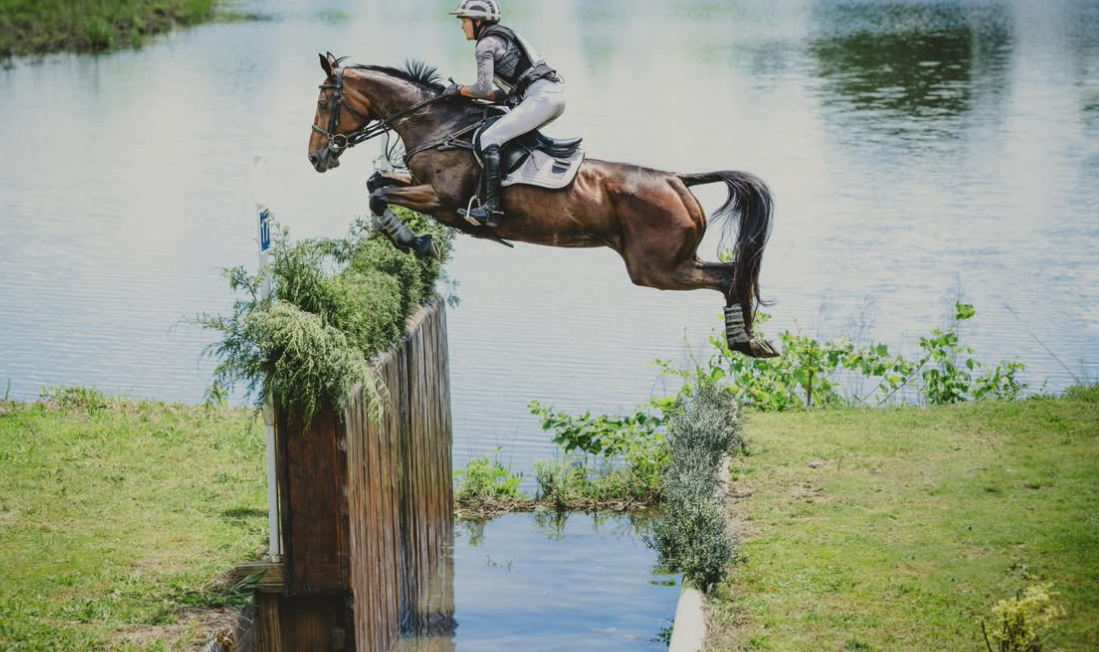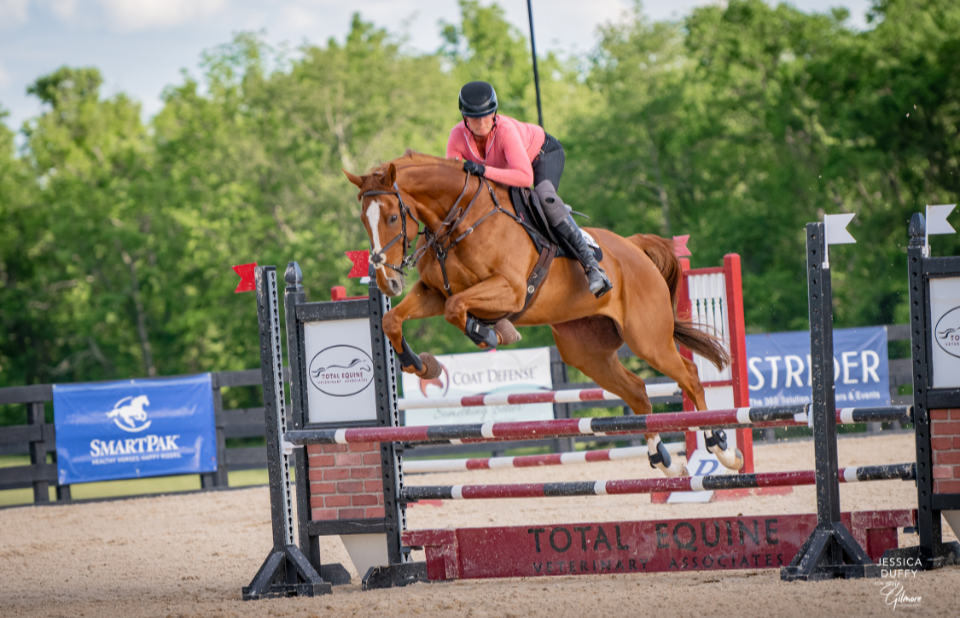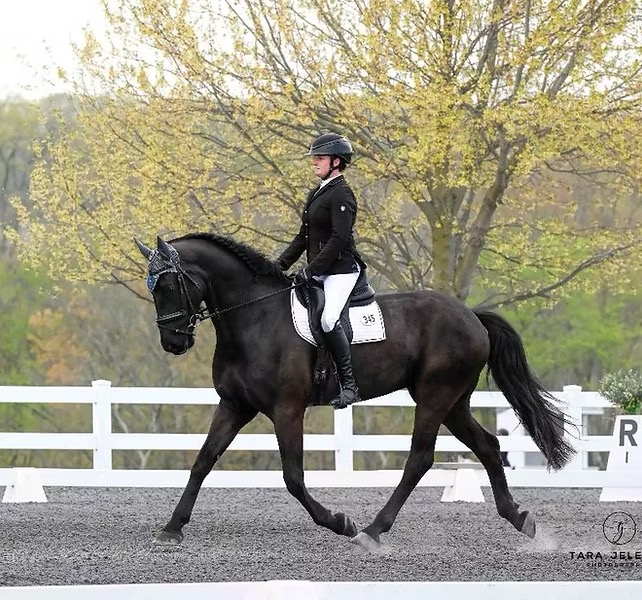If you’ve ever seen the incredibly interesting photos of horses with the musculoskeletal system intricately painted onto their coat, then you’re familiar with Gillian Higgins’ work.
For the first time since 2013, Gillian is coming to the United States to teach a clinic at Morven Park Equestrian Center in Leesburg, VA, made possible by the North American Saddlery School and HCS, USA Saddlery. I caught up with her to find out who she is, why she’s passionate about equine anatomy and biomechanics, and what riders can expect to learn from her. If you’re local to Leesburg, be sure to sign up for the Horses Inside Out clinic happening tomorrow (July 12) to learn from the expert herself!

Photo courtesy of Gillian Higgins
Prior to founding Horses Inside Out, Gillian had a varied career. She’s worked in all sorts of bodywork, for humans and horses alike, including working as a human sports and remedial therapist, equine sports massage therapist, equine chiropractic manipulator, and BHS Senior coach/trainer. She trained to be a human sports and remedial therapist at the Nottingham School of Massage and Manipulation, before learning equine sports massage with Mary Bromiley. Since then, she’s written 11 books on the subject of equine anatomy and biomechanics with topics ranging from pilates for horses to massage for horses.
After realizing how many of her clients and students could benefit from learning more about equine anatomy, Gillian started hosting small little clinics just for her contacts and it grew from there. Since founding Horses Inside Out in 2006, Gillian has taught at veterinary universities, to professional saddlers and saddle fitters, and to other therapists and equine bodyworkers. “Whatever we do with horses, the more we can learn about anatomy, the better we can ride, train, and look after our horses. For me, that’s what it’s all about. It’s making sure that we’re doing the best we possibly can to help these gorgeous, gorgeous horses,” Gillian said.

Gillian Higgins and Freddie Fox, photo courtesy of Gillian Higgins.
Q: You have a great quote on your website, “Study the bones of a horse well and they will tell you a story because anatomy reflects function.” Can you explain what you mean by that?
The more you study anatomy, the more you realize just how much of a story it can tell. For example, the shape of the bones, how they change, how they adjust. So if you take the natural shape first, that can give you information about what it’s designed to do. Why are muscles shaped the way they are? That can help us to understand how horses move, why they move that way, and perhaps why they don’t move in other ways. And I think that can help us to understand how and why we should be training our horses.
In the early days of Horses Inside Out, I had this fabulous horse named Freddie Fox. I had him from when he was five to when he was 25. And very sadly, in 2021 we had to have him put to sleep. I made the very difficult decision to build his skeleton and unveil it at our annual conference earlier this year. When I did my talk about it at the conference, I saw how many lives Freddie touched, through demonstrations, through my books, through our online academy. He has helped so many people to learn about anatomy and biomechanics.
After knowing him his whole life and then being able to see his skeleton really epitomized exactly what I mean when I say that bones tell a story. I could see everything about Freddie’s life through his skeleton, from his medical history to how he rode under saddle. On top of informing us about arthritic changes and other health issues, bones can tell us about muscular asymmetry through attachment points. If a horse is moving asymmetrically, you can actually see a slight change in the shape of the bone.
I suppose another example would be how anatomy reflects function in terms of posture. When we talk about improving a horse’s way of going, we’re talking about improving posture. So if you walk up to a yard and look at a horse and how he chooses to stand in that moment, you’ll have people say, “oh, that’s just because he’s slouching in that moment.” But, how you are in that relaxed moment is a reflection of how you are most of the time. So a horse standing in the yard with his hind leg out behind him, with his back down and the base of his neck forward– that is a reflection of how he’s going to be when ridden.
The more you study anatomy, the more it becomes more useful and allows you to better assess horses and improve the way you train.

Photo courtesy of Gillian Higgins
Q: How can Horses Inside Out benefit the average horse owner?
I think it’s up to us as horse owners, riders, and professionals to take responsibility for our horse’s posture and way of going. We have to think of ourselves as personal trainers to our horses and good personal trainers really know and understand the body and that’s basically what we’re talking about here. If we really understand the anatomy of the horse, the biomechanics, then we’re going to be able to better assess your horse, to better know what your horse needs, and to understand what you’re asking of the horse.
So yes, Horses Inside Out is about understanding anatomy. But actually it’s really about, what can we do about it? Learning what training is appropriate and what is the right sort of cardiovascular fitness, and understanding why we’re doing that cardiovascular fitness -– because we want our horses to be healthy.
Three things horse owners will learn through Horses Inside Out are:
1. Understanding how the weight of the rider comprises the horse’s posture, their ability to move, and their ability to balance. By ensuring your horse moves correctly, you’re making the horse’s job easier and more enjoyable.
Some of the muscles that support the rib cage effectively were designed to support the horse’s breathing. Yet, we have the weight of the rider on top of them, and those breathing muscles suddenly become load bearing. So, the question becomes how can we strengthen those muscles? Cardiovascular fitness, or getting your horse breathing hard, will strengthen those muscles and make your horse’s job easier.
2. Horses Inside Out encourages horse owners to think differently about fitness. For example, the question, “How fit does my horse need to be?” Let’s say I only hang out at the barn on the weekend and we just go for a walk down the road. Does that horse need to be cardiovascularly fit to just walk on a flat surface? Well, no he doesn’t. He’s not gonna get out of breath walking down the road.
Fit horses will have better posture, will have stronger backs, and will be better able to support their ribcage, which is what we’re sitting on. So yeah, the horse doesn’t need to be cardiovascularly fit to walk down the road. But if they are, they’re going to be so much better at carrying the weight of the rider.
3. Understanding equine anatomy puts more pieces of the puzzle in place and ultimately means we can better look after our horses. Horses Inside Out is about anatomy and biomechanics, but it’s also about understanding assessment exercises for improving posture, movement, and training performance.
We all love our horses and we want the best for our horses and I think this is particularly important in today’s world. We need to do everything that we possibly can to make sure that they are conditioned, including both musculoskeletal conditioning and cardiovascular conditioning. We have to ensure their bodies are strong and capable for the job that we’re asking them to do and so that they’re strong enough to enjoy the work we’re asking them to do.
Q: What is one thing you wish every rider knew about equine anatomy?
I wish every rider understood that the most common cause of riding-related injury in horses is repetitive strain. Very often people will say repetitive strain injury is caused by a rider doing too much canter work on hard ground, or drilling too much left shoulder-in, or practicing a specific dressage move over and over again. And all of those things are true, to a certain extent. Repetitive strain injury can be caused by all of these factors.
But repetitive strain injury is often caused by asymmetrical biomechanics in the horse’s body– or, putting it simply, bad posture.
When a body, horse or human, is in perfect posture it is also in perfect symmetry. And when it moves, the forces within the body will be evenly distributed. So for example, if you run and you have poor posture, let’s say you have a tendency to slump your shoulders and your head goes forward, you’re going to put more strain at the back of your neck.
If a horse has a tendency to go a little bit extended in the back and carry the base of the neck forward and down, which is the same sort of scenario as to the human running with slumped shoulders, you’re going to have more strain in certain areas. If you’ve got asymmetry within the body and poor posture, you’re going to have asymmetrical forces through the body. So if some areas get more force and others less force because your horse is working in a poor posture, it doesn’t matter how much you vary your training. Your horse could still develop a repetitive strain injury.
–
The Live Painted Demonstration will be taught by Gillian on July 12th at the Morven Park Equestrian Center in Virginia. Hosted by the North American Saddlery School and HCS, USA Saddlery, you can expect a mix of educational demonstrations, applicable exercises, and some vendor shopping. In true British fashion, there will be a tea break halfway through the clinic.
“We’re so thrilled to be bringing Gillian over to the United States,” said Amber Markley, co-owner of both the North American Saddlery School and HCS, USA Saddlery. “As a saddlery and saddlery school, we’re passionate about helping horse owners better understand how equine biomechanics impact performance and horse welfare, particularly when it comes to saddle fit. Bringing Gillian here to provide quality education and knowledge was a mission close to our hearts.”
Gillian brings her love and passion for horses to everything involved in Horses Inside Out. She says it’s not about memorizing the names of the bones, muscles, etc. “It’s about how we as riders, trainers, and owners, use that information to help our horses because at the end of the day, we all love our horses.”
If reading this article brought out your inner horse nerd, like me, click here to sign up for the clinic.
This article is brought to you thanks to support from Horses Inside Out, Gillian Higgins, North American Saddlery School, and HSC, USA. We’ll have a full recap of the clinic coming soon on EN!














































